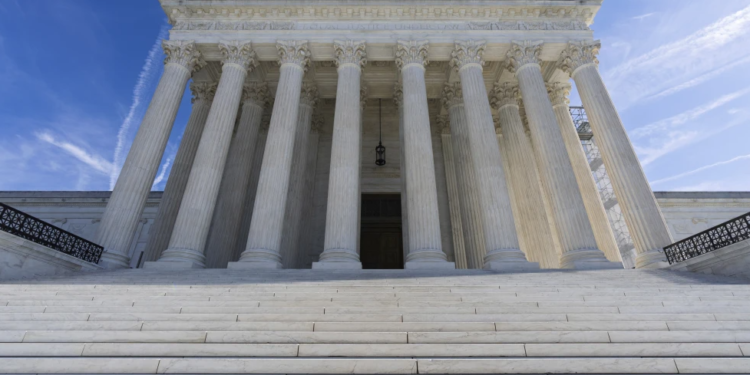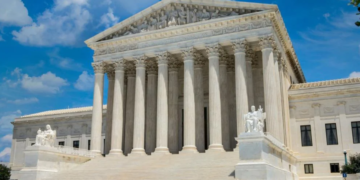November 21, 2025 Story by: Editor
The Supreme Court on Friday temporarily blocked a lower court ruling that struck down Texas’ 2026 congressional redistricting plan. The order, issued Friday and signed by Justice Samuel Alito, will remain in effect for at least the next few days as the Court considers whether to permit the new map for use in the midterm elections.
A three-judge federal panel on Tuesday, November 18, blocked Texas from using the newly drawn congressional district map approved earlier this year for the upcoming 2026 midterm elections, finding the plan likely constituted racial rather than purely partisan gerrymandering. The ruling marks a significant defeat for the Republican-led legislature and governor’s office, and triggered an immediate appeal to the Supreme Court of the United States.
Court ruling
The panel held that Texas must revert to the 2021 congressional map for the 2026 cycle while litigation proceeds. The judges’ 2–1 decision concluded that the 2025 map was drawn with race as the predominant factor in several districts—rather than traditional redistricting criteria such as geography, communities of interest, or partisan performance—thereby violating the Equal Protection Clause and the Voting Rights Act.
Key elements of the court’s reasoning include:
- The map aimed to flip five Democratic-held seats to Republicans, a goal explicitly pursued by the Texas legislature.
- A July letter from the U.S. Department of Justice to Texas officials directed the state to redraw four “coalition” districts—where no racial group held a majority but minority voters together did—on the theory that they violated Section 2 of the Voting Rights Act. The court found that letter legally incorrect, but concluded legislators adopted its racial objectives in drawing the map.
- The map reduced the number of coalition minority districts from nine to four, and dropped the count of majority-minority districts from 16 to 14, according to the court’s findings. Critics argued this dilution weakened minority voting strength.
- One judge wrote that “politics played a role … but it was much more than just politics.” The prevailing view of the court was that race was the driving factor.
Background
A Texas House redistricting panel approved a new congressional map on August 1, designed to create five additional GOP-leaning seats, solidifying Republican influence in the state’s U.S. House delegation. The proposal was quickly moved to the Texas Senate, which passed the measure and sent it to Governor Greg Abbott’s desk for signature. The map advanced on a strict party-line 12–6 vote, moving it closer to a full chamber vote as early as next week. The plan targets urban Democratic strongholds including Austin, Houston, and Dallas, reshaping district lines in South Texas and beyond to favor Republican performance.
Rep. Todd Hunter (R‑Corpus Christi), sponsor of House Bill 4, made no attempt to hide the partisan intent behind the plan. He explicitly stated that the goal was to use “political performance” as a benchmark, asserting the new lines would convert several districts into safe Republican victories—each projected to have delivered a Trump win by at least ten points in 2024.
State Democrats had few options to resist: delaying the legislation by denying quorum now carries a $500 per day fine, and quorum-busting walkouts were made politically risky due to concurrent flood-relief legislation. Across the state, prominent Texas Democrats—including Reps. Jasmine Crockett and Lloyd Doggett—denounced the map as racist gerrymandering, pointing out that some members are being drawn out of their own districts.
In 2024, Trump won 56.2% of votes in Texas. Under the current lines, Republicans hold 66% of Texas’ 38 House seats. The new map aims to push that share to 79%.
Texas state Republicans on Wednesday, July 30 unveiled a new congressional map that would give the GOP a clear path to flip five U.S. House seats currently held by Democrats—solidifying their grip on power ahead of the pivotal 2026 midterms.
The proposed map was filed by state Rep. Todd Hunter, who represents a coastal area in southeastern Texas and is a member of the state House Select Committee on Congressional Redistricting created last week as part of the special legislative session called by Republican Texas Gov. Greg Abbott.
But this time, with Republicans controlling both chambers of the Legislature and the Governor’s Mansion, they’re seizing the moment to expand their congressional majority from 25 to potentially 30 of the state’s 38 seats.
The GOP’s new map targets Democratic strongholds in Austin, Dallas/Fort Worth, Houston, and South Texas—reconfiguring districts to slice through liberal population centers and fold them into Republican-leaning suburbs and rural areas.
The new map targets Democratic-held districts in heavily urban metro areas—including Austin, Dallas/Fort Worth, Houston, and South Texas.
What is Texas’ House Bill 4
Texas’ House Bill 4 is a mid-decade congressional redistricting plan emerging from the 89th Texas Legislature’s second special session. It’s explicitly designed to redraw all U.S. House of Representatives districts in Texas, replacing prior maps, and is intended to take effect for the 2026 primary and general elections.
Key Details from the Legislation
- Adoption of PLANC2333: HB 4 utilizes a new mapping schema—PLANC2333—from the Texas Legislative Council. These maps are based on 2020 Census data and are precisely defined using geographies like census blocks and tracts.
- Repeal of Previous Maps: The bill repeals all existing congressional redistricting laws, including the 2021 map enacted during the 87th Legislature’s special session.
- Implementation Timeline: The new map will apply only to the elections beginning in 2026, leaving current district alignments unaffected until then.
Major changes affect:
- Districts of Reps. Julie Johnson and Marc Veasey in the Dallas/Fort Worth region, reshaped to weaken Democratic bases. Rep. Marc Veasey, who represents a majority-Black district in North Texas, sees his district splintered into pieces that dilute Black voting power—sparking immediate backlash from civil rights groups and Democratic lawmakers.
- The 9th and 18th districts in Houston, consolidating Rep. Al Green’s district with a vacancy and effectively shifting toward GOP voters. Rep. Al Green’s Ninth Congressional District in Houston would now be combined with the vacant 18th Congressional District to form a 61 percent Hispanic district in eastern Harris County, one that Trump would have won by 15 points.
- Districts held by Reps. Henry Cuellar and Vicente Gonzalez in South Texas—both heavily Hispanic and now projected to lean Republican under the new configuration.
- A projected new Austin–San Antonio swing seat, pitting Reps. Greg Casar and Lloyd Doggett potentially against one another, leaving one Democratic district in the region
Under the proposed boundaries, Trump would have carried 30 districts in Texas in 2024 by margins of 10 percentage points or more—a key indicator of GOP electoral strength under these lines.
Four of the five newly drawn GOP seats would be majority-Hispanic, including parts of South Texas and Houston—evidence of shifting reputational strategies targeting Hispanic voters.
Republicans assert the map creates two majority-Black districts (in Dallas and Houston) and adds one additional majority-Hispanic district—though critics argue this is a pretext for voter dilution.
Among the new majority-Black districts is the 18th Congressional District, centered in Houston, which has been represented by a decades-long run of renowned Black Democratic members, including Barbara Jordan, Mickey Leland, Sheila Jackson Lee and, most recently, Sylvester Turner, whose death in March left the seat vacant. The map proposes to pack even more Democratic voters into the solidly blue seat: Harris won the district with 69% in 2024 and would have carried it with 76% under the new boundaries.
The 18th District was among Texas’ four majority-minority congressional seats flagged by the U.S. Department of Justice as unconstitutional racial gerrymanders, a charge Texas Republicans have interchangeably denied in court and cited as the basis for pursuing mid-decade redistricting.
NAACP lawsuit
The National Association for the Advancement of Colored People (NAACP) filed a federal lawsuit seeking to block Texas’ newly approved congressional map, alleging it unlawfully dilutes the political power of Black voters. In a complaint filed in U.S. District Court, the civil rights group argues the state has engaged in racial gerrymandering to prevent Black voters from electing candidates of their choice.
The NAACP, together with the Lawyers’ Committee for Civil Rights Under Law, brought a lawsuit against the state of Texas in the U.S. District Court for the Western District of Texas, El Paso Division. The lawsuit names Texas Governor Greg Abbott, a Republican, and Secretary of State Jane Nelson, also a Republican, as defendants. It asks a judge to block the use of the new congressional map.
“The state of Texas is only 40% white, but white voters control over 73% of the state’s congressional seats,” said Derrick Johnson, president and CEO of the NAACP. “It’s quite obvious that Texas’s effort to redistrict mid-decade, before next year’s midterm elections, is racially motivated. The state’s intent here is to reduce the members of Congress who represent Black communities, and that, in and of itself, is unconstitutional.”
In a filing before the U.S. District Court for the Western District of Texas, the Texas NAACP has sought permission to supplement its Third Amended Complaint in the ongoing redistricting litigation. This motion, filed on August 26, 2025, comes in response to the Texas Legislature’s enactment of House Bill 4 (HB 4) on August 23, 2025, which introduces a new U.S. Congressional map.
The Texas NAACP contends that HB 4 perpetuates discriminatory practices against Black and other voters of color, mirroring issues identified in previous redistricting plans. The proposed supplement aims to incorporate these new allegations and identify additional affected members, maintaining the continuity of the original complaint under Federal Rule of Civil Procedure 15(d).
The motion emphasizes that the Texas NAACP’s request is timely and does not unduly prejudice the defendants, as they have indicated no opposition to the filing. The plaintiffs assert that the supplementation is directly related to the original claims and is necessary to address the recent legislative developments. The court’s approval of this motion would allow the plaintiffs to update their complaint to reflect the latest changes in the congressional map and continue their legal challenge against the alleged discriminatory redistricting practices.
According to census data, nonwhite residents account for nearly 60% of the state’s population, and Black Texans represent over 13%. Yet under the new congressional map, white voters — who comprise a shrinking plurality of the state — would effectively control 24 of Texas’s 38 congressional districts.
“We now see just how far extremist leaders are willing to go to push African Americans back toward a time when we were denied full personhood and equal rights,” the president of the Texas NAACP, Gary Bledsoe, said in a statement. “We call on Texans of every background to recognize the dangers of this moment. Our democracy depends on ensuring that every person is counted fully, valued equally and represented fairly. We are prepared to fight this injustice at every level. Our future depends on it.”
Implications for the 2026 mid-term and beyond
- Candidate plans disrupted: Republicans who had prepared to run in the newly drawn, more favorable districts now face uncertainty and may need to revise filings and campaign strategies. Democrats who had been drawn out of favorable seats may see a path reopened.
- Timing concerns: The candidate-filing deadline is approaching fast, raising logistical and legal complications if Texas must pivot back to the 2021 map without clarity from the Supreme Court.
- National ripple effect: This ruling underscores the heightened legal risk for mid-cycle redistricting efforts, especially when race appears to dominate the map-drawing process. States such as California and Missouri face parallel legal battles.
- Supreme Court test: If the high court grants emergency relief allowing the map’s use, or ultimately reverses the decision on the merits, it could redefine how much race may factor into redistricting under the federal standard. The outcome may recalibrate both partisan and racial-justice strategies nationwide.
The federal court’s ruling places Texas at the center of a pivotal fight over who decides how district lines are drawn and what role race can play in that process. With control of the U.S. House hanging in the balance and dozens of seats on the line, next year’s midterms may turn as much on legal maps as on electoral turnout.
Source: AP News /KLTV / Reuters / The Guardian / AP News
















